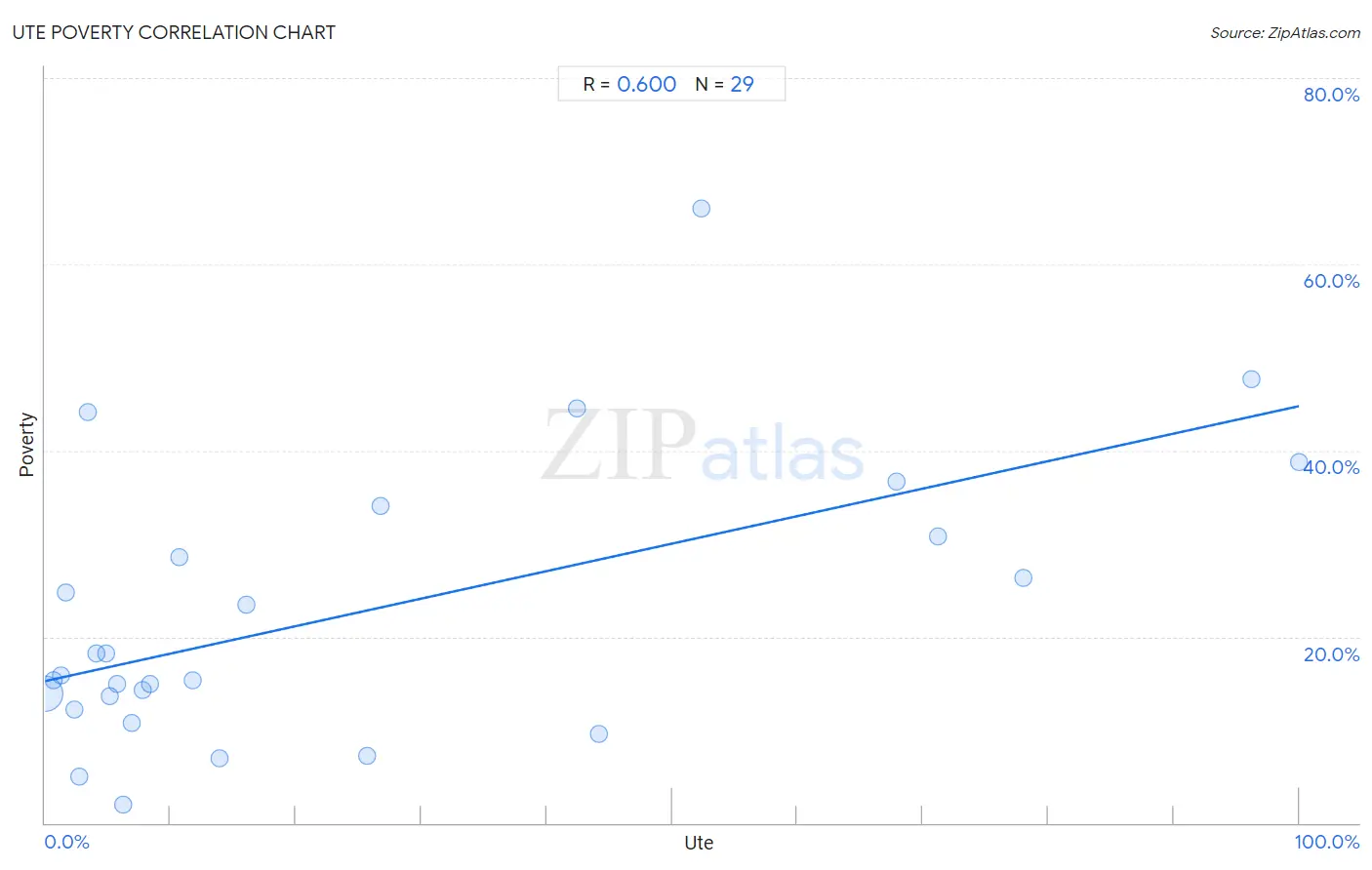Ute Poverty
COMPARE
Ute
Select to Compare
Poverty
Ute Poverty
16.9%
POVERTY
0.0/ 100
METRIC RATING
328th/ 347
METRIC RANK
Ute Poverty Correlation Chart
The statistical analysis conducted on geographies consisting of 55,667,697 people shows a significant positive correlation between the proportion of Ute and poverty level in the United States with a correlation coefficient (R) of 0.600 and weighted average of 16.9%. On average, for every 1% (one percent) increase in Ute within a typical geography, there is an increase of 0.30% in poverty level.

It is essential to understand that the correlation between the percentage of Ute and poverty level does not imply a direct cause-and-effect relationship. It remains uncertain whether the presence of Ute influences an upward or downward trend in the level of poverty level within an area, or if Ute simply ended up residing in those areas with higher or lower levels of poverty level due to other factors.
Demographics Similar to Ute by Poverty
In terms of poverty, the demographic groups most similar to Ute are Kiowa (16.8%, a difference of 0.43%), Paiute (16.7%, a difference of 0.96%), Central American Indian (16.7%, a difference of 1.3%), Yakama (16.7%, a difference of 1.5%), and Colville (16.6%, a difference of 2.0%).
| Demographics | Rating | Rank | Poverty |
| Arapaho | 0.0 /100 | #321 | Tragic 16.3% |
| Menominee | 0.0 /100 | #322 | Tragic 16.4% |
| Colville | 0.0 /100 | #323 | Tragic 16.6% |
| Yakama | 0.0 /100 | #324 | Tragic 16.7% |
| Central American Indians | 0.0 /100 | #325 | Tragic 16.7% |
| Paiute | 0.0 /100 | #326 | Tragic 16.7% |
| Kiowa | 0.0 /100 | #327 | Tragic 16.8% |
| Ute | 0.0 /100 | #328 | Tragic 16.9% |
| Blacks/African Americans | 0.0 /100 | #329 | Tragic 17.3% |
| Dominicans | 0.0 /100 | #330 | Tragic 17.6% |
| Immigrants from Dominican Republic | 0.0 /100 | #331 | Tragic 17.8% |
| Natives/Alaskans | 0.0 /100 | #332 | Tragic 18.1% |
| Houma | 0.0 /100 | #333 | Tragic 18.4% |
| Apache | 0.0 /100 | #334 | Tragic 18.4% |
| Cheyenne | 0.0 /100 | #335 | Tragic 18.9% |
Ute Poverty Correlation Summary
| Measurement | Ute Data | Poverty Data |
| Minimum | 0.028% | 2.0% |
| Maximum | 100.0% | 66.0% |
| Range | 100.0% | 64.0% |
| Mean | 24.8% | 22.6% |
| Median | 8.3% | 15.9% |
| Interquartile 25% (IQ1) | 3.7% | 12.9% |
| Interquartile 75% (IQ3) | 43.3% | 32.4% |
| Interquartile Range (IQR) | 39.5% | 19.5% |
| Standard Deviation (Sample) | 30.6% | 15.0% |
| Standard Deviation (Population) | 30.0% | 14.8% |
Correlation Details
| Ute Percentile | Sample Size | Poverty |
[ 0.0% - 0.5% ] 0.028% | 55,248,495 | 13.9% |
[ 0.5% - 1.0% ] 0.68% | 249,144 | 15.3% |
[ 1.0% - 1.5% ] 1.22% | 56,635 | 15.9% |
[ 1.5% - 2.0% ] 1.67% | 10,159 | 24.7% |
[ 2.0% - 2.5% ] 2.33% | 50,998 | 12.2% |
[ 2.5% - 3.0% ] 2.75% | 8,458 | 5.0% |
[ 3.0% - 3.5% ] 3.36% | 387 | 44.2% |
[ 4.0% - 4.5% ] 4.09% | 2,004 | 18.3% |
[ 4.5% - 5.0% ] 4.86% | 8,830 | 18.2% |
[ 5.0% - 5.5% ] 5.13% | 1,151 | 13.6% |
[ 5.5% - 6.0% ] 5.71% | 14,894 | 14.9% |
[ 6.0% - 6.5% ] 6.22% | 498 | 2.0% |
[ 6.5% - 7.0% ] 6.87% | 771 | 10.8% |
[ 7.5% - 8.0% ] 7.81% | 1,754 | 14.3% |
[ 8.0% - 8.5% ] 8.33% | 1,285 | 14.9% |
[ 10.5% - 11.0% ] 10.75% | 577 | 28.6% |
[ 11.5% - 12.0% ] 11.76% | 5,495 | 15.3% |
[ 13.5% - 14.0% ] 13.93% | 244 | 7.0% |
[ 16.0% - 16.5% ] 16.07% | 616 | 23.4% |
[ 25.5% - 26.0% ] 25.71% | 140 | 7.1% |
[ 26.5% - 27.0% ] 26.77% | 310 | 34.0% |
[ 42.0% - 42.5% ] 42.40% | 283 | 44.5% |
[ 44.0% - 44.5% ] 44.12% | 136 | 9.6% |
[ 52.0% - 52.5% ] 52.36% | 191 | 66.0% |
[ 67.5% - 68.0% ] 67.87% | 831 | 36.7% |
[ 71.0% - 71.5% ] 71.25% | 1,186 | 30.8% |
[ 78.0% - 78.5% ] 78.06% | 1,691 | 26.4% |
[ 96.0% - 96.5% ] 96.19% | 472 | 47.7% |
[ 99.5% - 100.0% ] 100.00% | 62 | 38.7% |